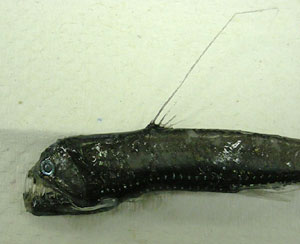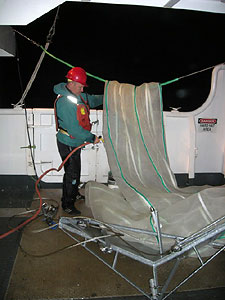

 | |||||||||
|
|
Journals 2008/2009Heather Judkins
August 3, 2008 One of the projects being conducted is deep water trawling at night using an IKMT net. This net is designed to flow through the water collecting any organisms in its path along the way. This net is deployed twice a night, once down to a depth of 500m and once down to 150m. The shallow trawl takes approximately one hour to complete and the deep tow takes approximately two and a half hours to complete.
This project is investigating the depth at which the midwater fish migrate up to while consuming smaller prey that move to the surface nightly to feed. There are some fascinating organisms that have been caught in the net. Examples of organisms caught include dragonfish, viperfish, lanternfish, jellyfish, deepsea squid, tons of shrimp species, and a large variety of zooplankton. Many of these organisms use bioluminescence in order to lure prey their way. In one of the translucent squid that was caught, you can actually see the smaller, bioluminescent fish inside its digestive organ.  One of the challenges of this project is the hours we need to work to collect these awesome organisms. We begin the tows around midnight and they are complete around 3:30 a.m. It's necessary to collect the samples at night, for the organisms aren't there during daylight hours as they are much deeper in the water. After the tows are completed, one of the scientists then has to process the samples by going through them, separating out organisms, and preserving them for future work on land. This leads to a 5 or 6 a.m. bedtime. There are great benefits to this project, making it well worth the late hours put into it. We are pulling up great specimens and slowly figuring out dominant species in this area as well as some predator/prey relationships between these animals. Question 1: What does IKMT stand for? Question 2: What are the layers of the ocean? Which layer does the IKMT reach? |
||||||||
